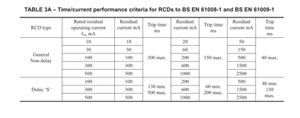Has anyone any experience calculating time delay maximum earth electrode resistance for time delayed RCDs, im looking at Table 3A in Appendix 3 but cant quite my head around it.
Standard 500ma would get 100ohms Ra.
(50v / 500ma) x 1000 = 100RA

The manufactuer used has setting for the 500ma time delay for 0.15s, 0.25s, 0.5s, 1s, 2.5s and 5s. I cant quite work out how that relates to the attached table.
Are the 0.15s and 0.25s faster than non delay? Id assume not, as its a delay
Some worked examples for the 500ma would be very helpful, im trying to discriminate with a downstream 300ma standard RCCB.
Thanks!